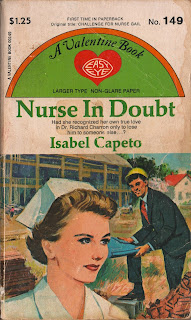By Arlene Fitzgerald, ©1967
Cover illustration by Mort Rosenfeld
Why had she really come to Silver Creek? She knew she wanted to help people in distress. Was being a nurse the best way? Was it the way to escape Ron? Now she would have to find the answers for two other people: the man who had stolen her heart and the one who had claimed it.
GRADE: B+
REVIEW:
This book was not bad, but reading a decent novel has seldom left me more
disappointed. Author Arlene Fitzgerald has delivered the awesomely dreadful Harbor
Nurse, so I had high hopes that I would encounter more fabulously
bizarre plot twists like the nurse ziplining out to a fishing boat during a
hurricane to help amputate the leg of a fisherman who was attacked by a shark.
Alas, no such excitement befalls Nurse Glee Barlow, who has volunteered to
spend a few weeks at the JCAHO-certified Silver Creek Clinic in Arizona in a
town with a population of 525. Like many VNRN heroines, she has a fiancé she doesn’t
think much of, yet cannot bring herself to decide she shouldn’t marry. Ron Snider
is a “terribly spoiled” mama’s boy, the apron strings
strengthened by the fact that mother is very rich. “Ron had been
proposing regularly, and he felt that she would be willing to settle down to a husband
and babies.” She, on the other hand, worked hard to become a nurse, and “wanted to
be free to do as she pleased as a full-fledged R.N. and as a woman at least,
for a while.”
En route to her clinic, Glee’s car is nearly hit by a horse-drawn carriage caroming out of a dude ranch. Slamming on the brakes and not wearing a seatbelt, she takes a blow to her sternum—or rather, “the steering wheel crushed the soft roundness of her breasts,” in typical Fitzgerald fondness for inserting sexual references into irrelevant descriptions. The carriage driver immediately pulls her from her car and starts fumbling with the buttons of her dress, insisting, “I’m not being fresh. I’m a qualified M.D.” Phew! Her relief is enhanced by the fact that Dr. Kirk Tesdal is one of those homely men who is nevertheless “unnervingly handsome,” and she drives off thinking she would like to see him again.
And she does! Because it turns out that he’s in town to interview for a job at the clinic, and though he’s superlatively qualified (his ineptness at unbuttoning blouses notwithstanding), he’s turned down for the job because he’s not married. Hmmm. When Glee arrives at the clinic, she finds that it’s holding a few cases of anthrax. You’ll be intrigued to know that Glee has a photographic memory, and recalls several pages of her medical textbook verbatim, even obligingly turning pages now and then for us, so we can appreciate the intricacies of the disease, which is treated with a lot of scrubbing up and incinerating clothes and bed linens, and injecting Dr. Tesdal with penicillin “into the firmness of his buttocks,” which Glee accomplishes while admiring his tan line and lean waist.
The medical staff manages several crises including another horse-drawn carriage crash that results in one victim requiring a splenectomy, a car crash in which the driver’s arm is nearly severed and handily sewn back on, and a heart attack. We are treated to some of Fitzgerald’s usual tricks, such as her fondness for “slashing” with a “firm mental scalpel” at any inconvenient thought, and her reliance on “firm nurse’s discipline” to get through difficult tasks like crossing a raging creek (of which there are many in the Arizona desert) on a fallen log. But overall the author’s idiosyncrasies, which have driven me practically insane in some books (see Young Nurse Rayburn), are infrequent here, and the worst sin she commits is the idiotic but unfortunately common trope of giving the heroine an unlikable fiancé yet rendering her completely shocked to discover in the final pages that she doesn’t really love the jerk after all. But there are some plusses as well, such as the fact that the medicine and surgery described in the book is detailed, interesting, and fairly accurate. Arlene Fitzgerald has given us one other B-grade book in Daredevil Nurse, so this completely readable and even entertaining book is not a total anomaly for her. But, paradoxically, I might have enjoyed a worse book more.






